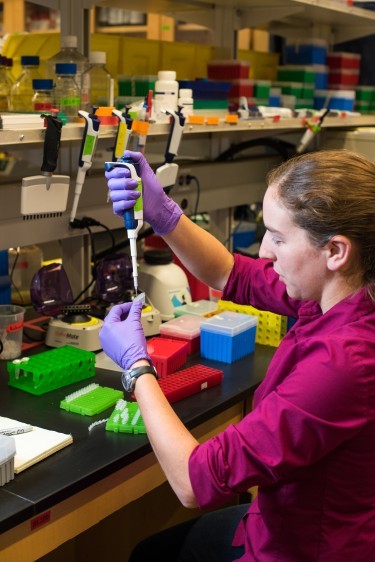By Ana Verayo, | April 11, 2016

Lee Organick, a UW computer science and engineering research scientist, mixes DNA samples for storage. Each tube contains a digital file, which might be a picture of a cat or a Tchaikovsky symphony.
If you think you do not have enough gigabytes for all your digital file storage needs, scientists now suggest a unique solution where they have developed a new kind of storage that can contain 700 terabytes worth of files, all inside a sliver of artificial DNA.
Researchers from the University of Washington apparently have successfully developed this nanogenetic technology that has the capacity to store data within a small strand of DNA that is so minute that it is invisible to the human eye.
Like Us on Facebook
This new, complete data storage system involving digital data in DNA strands can allow companies to safely keep their data similar to how a big box of groceries can shrink into a size of a sugar cube. The team of scientists and engineers have already completed this process of data storage and retrieval system using DNA molecules which means that if this is further developed and made it commercially available, this can ultimately change the future of data storage.
The team successfully encoded digital data of four image files into the nucleotide sequences of synthetic DNA segments. Scientists also believe that this kind of data storage solution is crucial where demand is estimated to grow in the 2020s, as digital files for storage can grow as much as 44 gigabytes. If proven to be efficient, this will become a gamechanger when it comes to data storage.
Researchers from the Molecular Information Systems Lab at the University of Washington along with Microsoft engineers described this storage and retrieval process as data that is being chopped into pieces which is stored by synthesizing a massive number of tiny DNA molecules. This DNA storage can then be dehydrated or preserved for longer data storage.
The files can be accessed and read via DNA sequencing methods, as it will be converted back into an image, video or document file to reorder the data. However, a major challenge in developing DNA storage is the expensive costs of creating artificial DNA.
According to the director of Science and Technology of IBM, Spike Narayan, researchers estimate that it will cost more than US $12,000 per megabyte to encode DNA data but only $200 to read this data and convert it back.
He hopes that DNA writing techniques will develop quickly since there has been enormous progress already for sequencing and reading DNA. Until the time comes when there is greater demand, there will be cost factors in seeing greater technological advances and adoptions for DNA data storage technology.
-
Use of Coronavirus Pandemic Drones Raises Privacy Concerns: Drones Spread Fear, Local Officials Say

-
Coronavirus Hampers The Delivery Of Lockheed Martin F-35 Stealth Fighters For 2020

-
Instagram Speeds Up Plans to Add Account Memorialization Feature Due to COVID-19 Deaths

-
NASA: Perseverance Plans to Bring 'Mars Rock' to Earth in 2031

-
600 Dead And 3,000 In The Hospital as Iranians Believed Drinking High-Concentrations of Alcohol Can Cure The Coronavirus

-
600 Dead And 3,000 In The Hospital as Iranians Believed Drinking High-Concentrations of Alcohol Can Cure The Coronavirus

-
COVID-19: Doctors, Nurses Use Virtual Reality to Learn New Skills in Treating Coronavirus Patients







